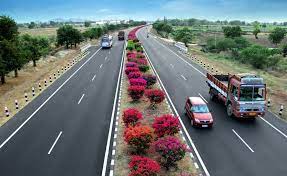
Pradhan Mantri Gram Sadak Yojana (PMGSY):
- On December 25, 2000, the Indian government announced its debut.
- The goal was to build all-weather roads that would connect all unconnected settlements with a population of 500 or more.
- The barrier is lowered for tribal areas, hills, and deserts, as well as any settlements with a population of more than 250. Implementing this programme is the responsibility of the Ministry of Rural Development (MoRD). This initiative is managed and supported technically by the National Rural Development Agency (NRRDA), a division of the Ministry.
- With the help of the Indian Roads Congress, the Ministry of Rural Development has already released Standard Data Book and specifications specifically for rural roads. This has aided in the establishment of national guidelines and standards for rural roads at the federal level for uniform implementation at the local level while properly taking into account the various topographies, soil types, and traffic patterns across the nation.
- The phrase “village connectivity programme” is commonly used.
- According to estimates, the PMGSY programme will require the construction of roughly 1.79 lakh disconnected habitations.
- This would include 3,75,000 km of new construction at an estimated cost of Rs. 78,000 crore and 3,72,000 km of renovations at an estimated cost of Rs. 59,000 crore.
National Highways Development Project (NHDP):
The National Highways Authority of India Act, 1988, a piece of parliamentary legislation, established the National Highways Authority of India.
The National Highways Development Project (NHDP)
- Which is India’s largest-ever highways project
- World-class roads with uninterrupted traffic flow, is implemented by NHAI.
It is responsible for the development, maintenance, and management of National Highways.
Through the various phases of the National Highways Development Project (NHDP), which are briefly described here, the Government of India has started significant endeavours to enhance and reinforce National Highways.
- NHDP Stage I: The Golden Quadrilateral (5,846 km), the NS-EW Corridor (981 km), port connection (356 km), and other projects make up the majority of NHDP Phase I, which the Cabinet Committee on Economic Affairs (CCEA) authorised in December 2000 at an estimated cost of Rs. 30,000 crore (315 km).
- NHDP Phase II: The NHDP Phase II, which totals 6,647 km in length and was approved by CCEA in December 2003 at an estimated cost of Rs. 34,339 crore (2002 prices), consists mostly of the NS-EW Corridor (6,161 km) and additional National Highways of 486 km length. Phase II is 6,647 kilometres long in total.
- NHDP Phase-III: On September 3, 2005, the government gave the go-ahead for the anticipated expenditure of Rs. 22,207 crores to upgrade and four-lane 4,035 km of national highways on a BOT basis (2004 prices).At an estimated cost of Rs. 54,339 crores, the government approved upgrading and installing 4 lanes on 8074 km in April 2007.
- NHDP Phase IV: On October 5, 2006, CCEA approved repaving 6,500 km of existing four-lane highways as part of NHDP Phase V. (on DBFO basis). 5,700 km of the Golden Quadrilateral and other parts are included in the 6,500 km six-laning.
- NHDP Phase V: The CCEA approved 1000 km of expressways in November 2006 at an estimated cost of Rs. 16680 crores.
- NHDP Phase VI: The CCEA approved 700 km of Ring Roads, Bypasses, and Flyovers as well as a few chosen segments in December 2007 for an estimated cost of Rs. 16680 crores.
